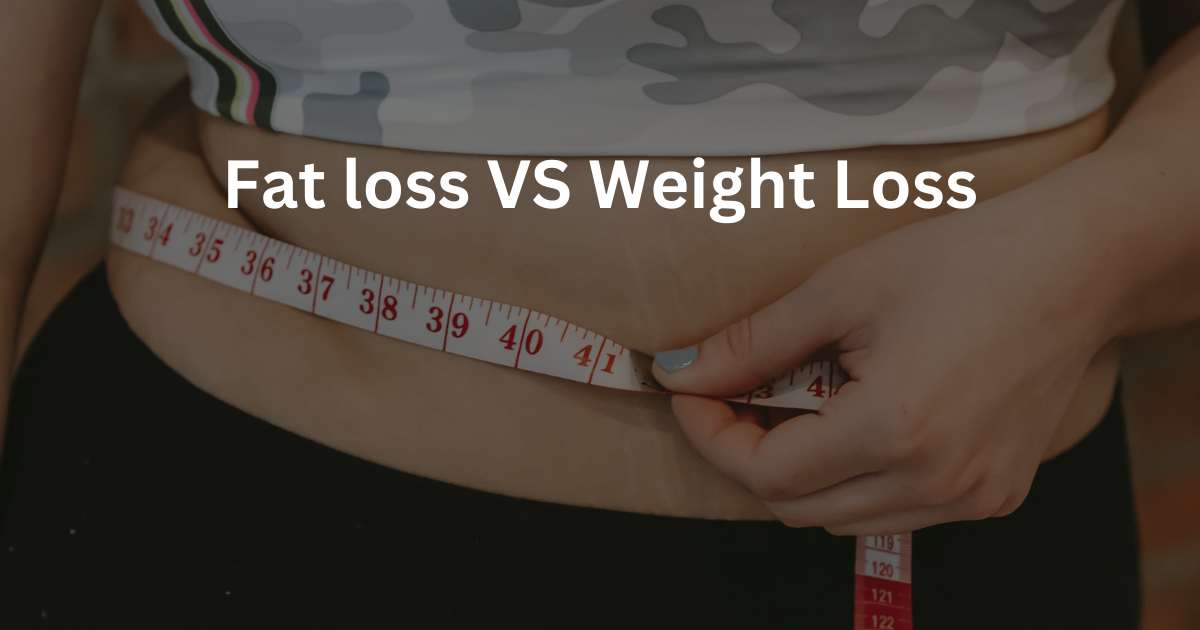When it comes to health and fitness, you hear the words fat loss or weight loss all of the time but they are two totally separate things with very different meanings. So, even though a lot of these terms are used interchangeably by many people, in reality they differ quite a bit and having this distinction is important for setting realistic goals & ultimately getting the results you want.
Losing fat simply means reducing body weight in the form of stored fat while maintaining muscle, and everything else (such as water, organ weight,… etc). This article is going to look at the details of fat loss and weight reduction in terms of their respective effects on health, aesthetics as well as long term sustainability. A deeper knowledge of these principles helps people to choose the right approach correlating them with their objectives.


What Is The Difference Between Weight Loss And Fat Loss?
Both of these terms are frequently used interchangeably, but they have very different implications for your health/physical appearance – so let us clear the air.
- Weight loss: The decrease in body weight that may be due to a reduction of water, muscle or fat. But such a deficit can be obtained by many different means — eating fewer calories, exercising more and changing the composition of one’s diet.
- Fat loss: The reduction in body fat with a focus on an increase or at the very least maintenance of lean muscle mass; functional interpretation is optimization of a given tissue (ie, being adipose) relative to a set standard.
Why Your Goal Should Be Fat Loss, Not Weight Loss
The key to this article will lay in the title: fat loss over weight loss and here are many reasons why this is true.
Better body composition — i.e., losing fat and maintaining muscle mass, which leads to a leaner, more toned physique.
Good health risks: Increased body fat in general is a risk factor for diseases, particularly of the cardiovascular system; diabetes and some cancers(decubitus position) Fat loss targets lead to improved overall health.
Lasting Results: Losing fat through proper diet (crash diets fad lowcarb) and exercise is far more sustainable compared to quick shortcuts/methodologies
How to Lose Fat and Retain Muscle Mass
The key to fat loss without muscle loss is good nutrition, lifting heavy weights and doing high-intensity interval cardio. Some ways to do this are:
- Calorie deficit: Consume slightly less than what is required to establish a mild calorie shortness. It does this by increasing the amount of energy your body puts out (burned calories), in turn promoting fat loss instead of muscle. If you want to drop some body fat, aim for a daily deficit of 500-750 calories per day.
- Protein: Eat enough protein to maintain and repair muscle. And shoot for about 0.8–1 gram of protein per pound body weight High-protein options: poultry, lean meats, fish, legumes (including soy products such as tofu), dairy and eggs
- Strength Training: Add muscle building exercise in your routine. This assists in muscle preservation and growth but facilitates fat loss. Focus on compound movements that use a lot of muscles at once such as squats, deadlifts lunges and bench presses.
Cardio-vascular exercise, this will help you to burn calories and also support fat loss rallied all over. Think swimming, running, cycling or even HIIT (high-intensity interval training). Exercise at least 150 minutes of moderate-intensity or 75 minutes of vigorous intensity cardio each week.
- Sleep and rest: Greater sleep means better fat burning, a great recuperative aid for muscles. If you’re aiming to build muscle, then your focus needs to shift toward getting (hopefully) 7-9 hours of quality sleep each night AND incorporating rest days into the mix.
8 Signs You Are Burning Fat
1. Smaller body measurements; if your clothes feel looser or you notice that inches have been reduced from around the middle of your waist, hips and other areas on the body therefore it means fat is being lost as of writing this.
2. Boosted energy levels: Your body needs to burn through all the excess fat, and this increases your stamina quite naturally.
3. Muscle definition : as body fat is reduced muscle detail starts to show through more, leading you look toned and even somewhat chiselled around your muscles
4. Stay as strong or stronger: Make sure that when in the process of losing fat, you can still maintain strength levels so you know it’s all fat loss and minimum muscle.
5. Increased endurance During cardiovascular activities, and Your body starts using stored fat for energy more efficiently
6. Improvements in mood and brain function: Regular exercise like this will help stabilise your moods, reduce the cortisol floating around through your veins day-in-day-out and increase mental clarity with an all-time low amount of body fat.
7. Reduced Body Fat Percentage: Although the weighing scale tells you how much weight you have lost but to determine how successful your diet has been, monitoring a reduction in your Body Fat with methods like bio impedance scales or skin fold callipers can paint a very different picture.
8. Slow and steady wins the race: Fat cannot be lost overnight. ✅ If you are continuously working out to lose fat and you can see progress -even slow one- then just continues like that.
Keep in mind that weight-loss results may vary, and fat loss occurs slowly. One of the crucial words is looking at long term habits and really health rather than just a rush for results. Seek out the advice of a healthcare professional, or talk to someone certified for exercise as you go along your progress toward fat loss.
Conclusion
In summary, fat loss refers specifically to the reduction of fat tissue in the body, which is often associated with improved health, metabolic function, and aesthetics. Weight loss, on the other hand, encompasses the reduction of overall body weight, which can include water, muscle, and fat. Prioritising fat loss typically leads to better long-term health outcomes, as it promotes the preservation of lean muscle mass and enhances overall body composition. Understanding this distinction is crucial for setting realistic fitness goals and implementing effective weight management strategies.




